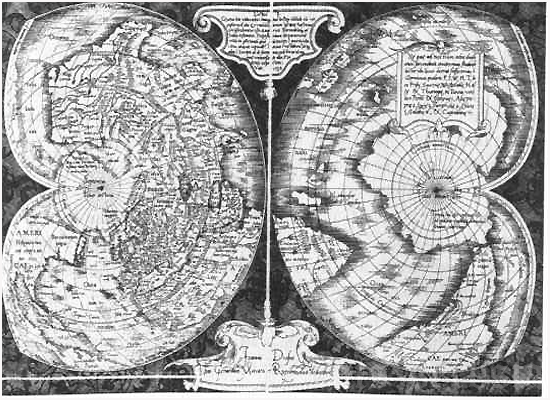Post by blacky on Jan 26, 2010 22:32:20 GMT 10
On the Origins of Unexplained Maps
The following is an investigation into a series of cartographers (map-makers) who have themselves (whether partially or wholly) developed some maps which to this day do not comply with conventional history and the progression of science and man’s exploration of our world. When one examines the following with an open mind, one should not leave this thread without some sense of unease in regards to our accepted history. The content below was inspired by some of my favorite authors such as J.N. Wilford and G. Hancock.
“A good map is both a useful tool and a magic carpet to far away places.”
-Anon
Piri Reis & The Inexplicable Map
Piri Reis was an Ottoman-Turk explorer, admiral and cartographer. He compiled his infamous map in 1513 at Constantinople. The map shows the western coasts of North Africa, the coast of Brazil and an ice-free Antarctica. This last fact is heavily disputed, but we would not be here if this were not the case. Considering the fact that Antarctica was ‘officially’ discovered in 1818, we are left with a perplexing conundrum. The depiction of the sub-glacial topography could not have been technologically possible in Piri Reis’ time or in a time prior to his, yet he had information depicting just this and conveyed it in his own way. Sub-glacial topography of the region was not officially mapped in modern history until as recently as 1949. To further enforce the oddity of this enigma, the last time that Queen Maud Land (the part of Antarctica depicted on the map) was in ice-free condition was no later than 4200B.C.E. It is not plausible therefore, for Piri Reis to have been the original cartographer of this area since it was still covered in ice during his time. So who was?

PIRI REIS MAP
Piri Reis wrote some notes on his map which detailed his sources. He admits that he was not the original cartographer of the works depicted in his map; he states that he merely compiled a number of source maps into one piece. He claimed to have used the source maps of Columbus among other earlier explorers, but some sources he claimed, went back to 400B.C.E. and even earlier. These source maps were most likely derived from the Imperial Library in Constantinople since this was Reis’ main source of information and where his map was originally discovered. Where did these source maps come from? Who could have mapped the topography of Antarctica prior to the glaciation before our modern era?
Oronteus Finaeus & Ancient Sources
Oronteus Finaeus’ world map dates back to 1531. The map appears to depict the world (on the left) and the Antarctic continent (on the right). What may be even more startling than the Piri Reis map is that the Finaeus map depicts mountain ranges which match closely modern day sub-glacial analysis of the topography. Does this mean that not only were the Antarctic coasts explored but the mainland itself? Maybe, but inserting a plausible date for this would raise more eyebrows than the Piri Reis speculation, as it would mean that there were cartographers on the map no later than the end of the last Ice Age; the end of the last Ice Age glacial period was 12500 years ago!

FINAEUS MAP
Closer inspection of the map reveals not only mountain ranges, but rivers aswell. The depiction of the Ross Sea Ice Shelf shows indications of rivers where today there are glaciers such as the Beardmore which spill into the sea. What this means is that there was no ice in these areas when the source maps that Finaeus used were made. If these rivers did indeed exist then there would have had to have been woodlands in the area in order to feed the rivers. When testing was done in 1949 using core tubes to check the sediment layers at the bottom of the Ross Sea some interesting finds were made. They revealed that many layers were composed of fine grained sediments which could only have been brought down to the sea by flowing rivers. So was the Oronteus Finaeus map created from the same sources as the ones used by Piri Reis? Who could have charted these areas when they were inaccessible for the last 6000 years?
The Mysterious Mercator
Gerard Kremer, also known as Mercator was a sixteenth century cartographer. He was widely known for his enigmatic behavior and was well recognized as a collector of antique maps. In his Atlas of 1569, Mercator depicts the Finaeus map, including Antarctica. Many areas which were then discovered are depicted on his map including Marie Byrd Land, Alexander I Island, the Weddell Sea and even the Regula Range in Queen Maud Land. In some cases the features are more visible and clearer than on the Finaeus map, perhaps suggesting that they had varying source maps?

MERCATOR MAP
The question still remains, how is it possible that these cartographers had such precise knowledge in a time when such advances were not supposed to have been made?
Buache & The Splitting Sea
Perhaps we have saved the best for last (taking no credit from Mercator, perhaps the greatest map-maker). Philippe Buache was an 18th century French cartographer and geographer. What sets Buache aside from the likes of Reis, Finaeus and even Mercator, is that his depiction of Antarctica is one that is perhaps thousands of years older than any of the above. What Buache’s map shows is an Antarctica as it would have looked like completely ice-free! It is a complete sub-glacial topography of the entire continent!

BUACHE MAP
The sources he used are now lost, but his map depicts Antarctica as two separate land masses, where as now there lie the Trans-Antarctic Mountains. The 1958 IGY survey shows that Antarctica is indeed an archipelago (a group of islands) connected by many mile-thick ice packed between them, sitting above the sea level. Therefore an ice-free Antarctica would mean that the waterway depicted in Buache’s map would have connected the Bellinghausen, Ross and Weddell seas. Therefore rendering Buache’s depiction strangely accurate. Once again, how is this possible?
The following is an investigation into a series of cartographers (map-makers) who have themselves (whether partially or wholly) developed some maps which to this day do not comply with conventional history and the progression of science and man’s exploration of our world. When one examines the following with an open mind, one should not leave this thread without some sense of unease in regards to our accepted history. The content below was inspired by some of my favorite authors such as J.N. Wilford and G. Hancock.
“A good map is both a useful tool and a magic carpet to far away places.”
-Anon
Piri Reis & The Inexplicable Map
Piri Reis was an Ottoman-Turk explorer, admiral and cartographer. He compiled his infamous map in 1513 at Constantinople. The map shows the western coasts of North Africa, the coast of Brazil and an ice-free Antarctica. This last fact is heavily disputed, but we would not be here if this were not the case. Considering the fact that Antarctica was ‘officially’ discovered in 1818, we are left with a perplexing conundrum. The depiction of the sub-glacial topography could not have been technologically possible in Piri Reis’ time or in a time prior to his, yet he had information depicting just this and conveyed it in his own way. Sub-glacial topography of the region was not officially mapped in modern history until as recently as 1949. To further enforce the oddity of this enigma, the last time that Queen Maud Land (the part of Antarctica depicted on the map) was in ice-free condition was no later than 4200B.C.E. It is not plausible therefore, for Piri Reis to have been the original cartographer of this area since it was still covered in ice during his time. So who was?

PIRI REIS MAP
Piri Reis wrote some notes on his map which detailed his sources. He admits that he was not the original cartographer of the works depicted in his map; he states that he merely compiled a number of source maps into one piece. He claimed to have used the source maps of Columbus among other earlier explorers, but some sources he claimed, went back to 400B.C.E. and even earlier. These source maps were most likely derived from the Imperial Library in Constantinople since this was Reis’ main source of information and where his map was originally discovered. Where did these source maps come from? Who could have mapped the topography of Antarctica prior to the glaciation before our modern era?
Oronteus Finaeus & Ancient Sources
Oronteus Finaeus’ world map dates back to 1531. The map appears to depict the world (on the left) and the Antarctic continent (on the right). What may be even more startling than the Piri Reis map is that the Finaeus map depicts mountain ranges which match closely modern day sub-glacial analysis of the topography. Does this mean that not only were the Antarctic coasts explored but the mainland itself? Maybe, but inserting a plausible date for this would raise more eyebrows than the Piri Reis speculation, as it would mean that there were cartographers on the map no later than the end of the last Ice Age; the end of the last Ice Age glacial period was 12500 years ago!

FINAEUS MAP
Closer inspection of the map reveals not only mountain ranges, but rivers aswell. The depiction of the Ross Sea Ice Shelf shows indications of rivers where today there are glaciers such as the Beardmore which spill into the sea. What this means is that there was no ice in these areas when the source maps that Finaeus used were made. If these rivers did indeed exist then there would have had to have been woodlands in the area in order to feed the rivers. When testing was done in 1949 using core tubes to check the sediment layers at the bottom of the Ross Sea some interesting finds were made. They revealed that many layers were composed of fine grained sediments which could only have been brought down to the sea by flowing rivers. So was the Oronteus Finaeus map created from the same sources as the ones used by Piri Reis? Who could have charted these areas when they were inaccessible for the last 6000 years?
The Mysterious Mercator
Gerard Kremer, also known as Mercator was a sixteenth century cartographer. He was widely known for his enigmatic behavior and was well recognized as a collector of antique maps. In his Atlas of 1569, Mercator depicts the Finaeus map, including Antarctica. Many areas which were then discovered are depicted on his map including Marie Byrd Land, Alexander I Island, the Weddell Sea and even the Regula Range in Queen Maud Land. In some cases the features are more visible and clearer than on the Finaeus map, perhaps suggesting that they had varying source maps?

MERCATOR MAP
The question still remains, how is it possible that these cartographers had such precise knowledge in a time when such advances were not supposed to have been made?
Buache & The Splitting Sea
Perhaps we have saved the best for last (taking no credit from Mercator, perhaps the greatest map-maker). Philippe Buache was an 18th century French cartographer and geographer. What sets Buache aside from the likes of Reis, Finaeus and even Mercator, is that his depiction of Antarctica is one that is perhaps thousands of years older than any of the above. What Buache’s map shows is an Antarctica as it would have looked like completely ice-free! It is a complete sub-glacial topography of the entire continent!

BUACHE MAP
The sources he used are now lost, but his map depicts Antarctica as two separate land masses, where as now there lie the Trans-Antarctic Mountains. The 1958 IGY survey shows that Antarctica is indeed an archipelago (a group of islands) connected by many mile-thick ice packed between them, sitting above the sea level. Therefore an ice-free Antarctica would mean that the waterway depicted in Buache’s map would have connected the Bellinghausen, Ross and Weddell seas. Therefore rendering Buache’s depiction strangely accurate. Once again, how is this possible?












 The location of the source of these images is given below in yellow:
The location of the source of these images is given below in yellow: Besides the sonar images, also some video footage was made by remote camera, from which the following stills originate:
Besides the sonar images, also some video footage was made by remote camera, from which the following stills originate:





 Happy New Years Everybody!!!
Happy New Years Everybody!!!
